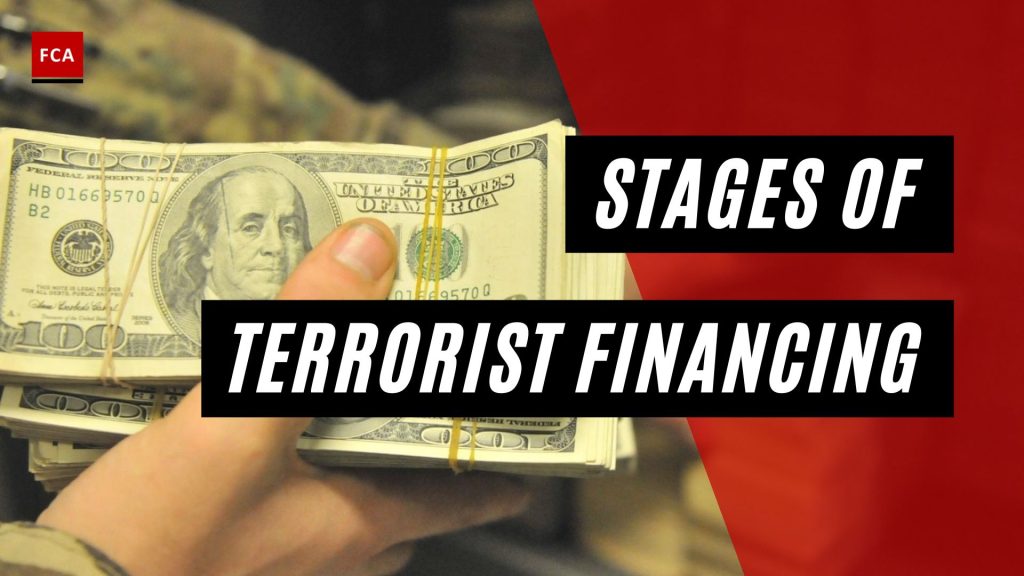Understanding the stages of terrorist financing is essential to developing effective counter-terrorism strategies and disrupting terrorist networks. Terrorist organizations and even individual terrorists and insurgents require financial support. This money is generated by either lawful or unlawful means and is usually transferred through illegal means like money laundering, which makes it another form of financial crime. Terrorist financing using cryptocurrencies follows four stages: Collecting, Storing, Moving, and Using.

Stages of Terrorist Financing
The first stage is the collecting stage which refers to generating funds intended for a terrorist or terror organization. The most common sources of terrorist funding are state sponsorship, charitable or personal donations, illegal activities, and legal business activities. Illegal activities include drug trafficking and other smuggling, fraud, extortion, and petty crime. Legal activities include salaried employment, legitimate businesses, and personal or credit-based loans. A terrorist group’s choice of source varies greatly according to availability and group preferences and may evolve. The success of intelligence and law enforcement agencies in constraining the ability of terrorist groups to raise money can lead terrorist organizations to search for alternative fundraising methods, which in turn leads authorities to develop new countermeasures.
Terrorists may be supported in the receipt of funding through various means. For example, many supporters of terrorist organizations have not been donating as much to terrorist groups as they did in the past because of an increase in the legal and financial risks involved in doing so. Paying donations is a significant source of terrorist financing. Supporters might donate their money to transfer funds through broker intermediaries.
In addition, the sale of illegal goods and drug trafficking also may be critically assisted by funds. In the trafficking of goods, especially drugs, terrorist groups are usually involved.
The second stage is the storing stage. It involves that once funds are generated, terrorist organizations must store and manage the money. To understand this, put yourself in the shoes of a fundraiser of a terrorist organization for a moment. You have received some money from direct donations in amounts large and small, given by individuals, legal entities, non-profit organizations, or businesses, and, in some cases, foreign countries. What do you do with this? You bundle it to make it easier to handle and store it somewhere.
The storing of funds can be accomplished through means such as bank and other accounts, high-value commodities such as oil, art and antiquities, agricultural products, precious metals and gems, and even used vehicles. Large terrorist organizations often rely on relatively sophisticated financial infrastructure with multiple levels of management, reporting, accounting, and financial planning. Especially terrorist organizations under attack, like ISIS, must pay attention to the robustness of their financial systems to limit or prevent losses of personnel, sites, or records.

The third stage is moving the funds. When the terror group has as many funds as required and an operational need, they move funds from the store to somewhere else. If the money received is not yet under the direct control of the terrorist organization or if it cannot be transferred because of operational security concerns, they use money laundering and other transfer mechanisms.
Useful ways in which terrorist organizations transfer money include the following:
- Cash couriers
- Informal transfer systems
- Money service businesses
- Formal banking
- False trade invoicing, and
- High-value commodities
Although these are important to terrorist organizations, transaction volume is particularly critical because most transactions occur within a few specific countries and are either internal fund transfers or settlements between known parties. Large transactions may therefore be difficult and noticeable.
Finally, the fourth and the last stage is using. Terrorist groups use the funds they have collected. We can differentiate between operating costs and costs to produce violence. The same mechanisms typically fund both categories.
Different terrorist groups will budget differently based on their needs and goals, and the operations to track and disrupt the activities of such groups will have different effects, depending on the choices made. It is difficult to separate licit operations and expenses, such as salaries and social services, from clearly illicit spending, such as terrorism recruitment and training. For example, operating costs, such as propaganda, recruitment, salaries, and social services, indirectly contribute to an organization’s ability to produce violence.
Most terrorist groups are currently constrained in their ability to use cryptocurrency because of the limited acceptability and usability of these currencies in the regions in which terrorist groups operate. Even if a group receives and manages these funds, they cannot easily be used to pay for expenses where vendors and members expect cash, either in stable currencies like dollars and euros or in local currencies. For instance, few Bitcoin ATMs exist in the Middle East, making exchanging Bitcoins for fiat currencies challenging. Bitcoin ATMs are more prevalent in Europe and the United States, where local banking and currency laws deter illicit use.

Final Thoughts
Terrorist financing is the process through which terrorists obtain, transfer, and use funds to support their illicit activities. It is a critical component of terrorism, as without funding, terrorists would be unable to carry out their attacks and sustain their operations over time. The importance of understanding the stages of terrorist financing lies in the fact that disrupting any one of these stages can significantly impact a terrorist organization’s ability to operate.
Effective counter-terrorism measures must focus on identifying and disrupting the various stages of terrorist financing through improved intelligence gathering, financial tracking, and regulatory oversight. This can involve measures such as freezing assets, disrupting informal money transfer systems, and increasing transparency and accountability in the financial sector. Ultimately, disrupting the financing of terrorist organizations is essential to protecting national security and preventing terrorist attacks.








